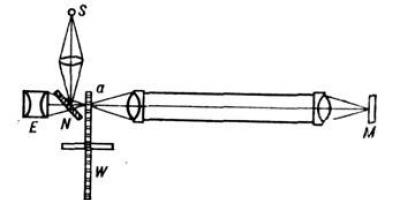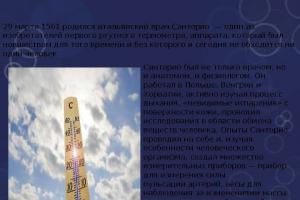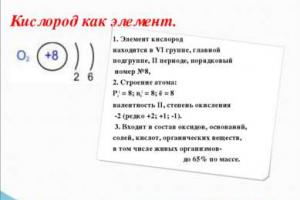(including light); one of the funds physical permanent; represents the maximum speed of propagation of any physical. influences (see Relativity theory) and is invariant upon transition from one reference system to another.
S. s. in the environment With" depends on the refractive index n of the medium, which is different for different frequencies v ( Light dispersion):. This dependence leads to the difference group velocity from phase speed light in the environment, if we are not talking about monochromatic. light (for solar radiation in a vacuum these two quantities coincide). By experimentally determining With", always measure group S. s. or so-called signal speed, or energy transfer rate, only in certain special cases. cases not equal to the group one.
For the first time S. s. determined in 1676 by O. Ch. Roemer from the change in time intervals between eclipses of Jupiter's satellites. In 1728 it was established by J. Bradley, based on his observations of the aberration of starlight. In 1849, A.I.L. Fizeau was the first to measure S. s. by the time it takes light to travel a precisely known distance (base); Since the refractive index of air differs very little from 1, ground-based measurements give a value very close to c. In Fizeau's experiment, a beam of light from a source S(Fig. 1), reflected by a translucent mirror N, periodically interrupted by a rotating toothed disk W, passed the base MN(approx. 8 km) n, reflected from the mirror M, returned to the disk. When the light hit the tooth, it did not reach the observer, and the light that fell between the teeth could be observed through the eyepiece E. Based on the known speeds of rotation of the disk, the time it took light to travel through the base was determined. Fizeau obtained the value c = 313300 km/s. In 1862, J. B. L. Foucault implemented the idea expressed in 1838 by D. Arago, using a rapidly rotating (512 rpm) instead of a toothed disk. c) mirror. Reflecting from the mirror, the beam of light was directed to the base and upon returning again fell on the same mirror, which had time to rotate through a certain small angle (Fig. 2). With a base of only 20 m, Foucault found that S. s. equal to 298000 500 km/s. Schemes and basics the ideas of Fizeau's and Foucault's experiments were repeatedly used in subsequent works on the definition of S. s. Obtained by A. Michelson (see. Michelson experience) in 1926, the value of km/s was then the most accurate and was included in the international. physical tables quantities 
Rice. 1. Determination of the speed of light by the Fizeau method.

Rice. 2. Determination of the speed of light by the rotating mirror method (Foucault method): S - light source; R - rapidly rotating mirror; C is a fixed concave mirror, the center of which coincides with the axis of rotation R (therefore, the light reflected by C always falls back on R); M-translucent mirror; L - lens; E - eyepiece; RC - accurately measured distance (base). The dotted line shows the position R, which has changed during the time the light travels the path RC and back, and the reverse path of the beam of rays through the lens L, which collects the reflected beam at point S", and not again at point S, as would be the case with a stationary mirror L. Velocity lights are set by measuring the displacement SS".
Measurements of S. s. in the 19th century played a big role in, further confirming the wave theory of light. A comparison of S. s. made by Foucault in 1850. the same frequency v in air and water showed that the speed in water is in accordance with the prediction of wave theory. A connection between optics and the theory of electromagnetism was also established: measured S. s. coincided with the speed of the el-magn. waves calculated from the el-magnetic ratio. and el-static. units of electricity charge [experiments of W. Weber and F. Kohlrausch in 1856 and subsequent more accurate measurements by J. C. Maxwell]. This coincidence was one of the starting points for Maxwell's creation of the electric magnet in 1864-73. theories of light.
In modern measurements of S. s. modernized is used. Fizeau method (modulation method) with the replacement of a gear wheel with an el-optical, ., interference or other. another light modulator that completely interrupts or weakens the light beam (see Light modulation The radiation receiver is a photocell or photomultiplier tube.Application laser as a light source, ultrasonic modulator with stabilizer. frequency and increasing the accuracy of measuring the base length made it possible to reduce measurement errors and obtain a value of km/s. In addition to direct measurements of S. s. based on the time of passage of a known base, indirect methods are widely used, giving greater accuracy. So, using microwave vacuum cleaners. [TO. Froome (K. Froome), 1958] at a radiation wavelength = 4 cm, the value km/s was obtained. S. s. is determined with an even smaller error. as the quotient of division of independently found and v atomic or molecular spectral lines. K. Evenson and his associates in 1972 on the cesium frequency standard (see Quantum frequency standards) found the radiation frequency of the CH 4 laser with an accuracy of up to the 11th digit, and using the krypton frequency standard - its wavelength (approx. 3.39 μm) and obtained ± 0.8 m/s. By the decision of the General Assembly of the International Committee on Numerical Data for Science and Technology - KODATA (1973), which analyzed all available data, their reliability and error, S. p. in a vacuum is considered to be equal to 299792458 ±1.2 m/s.
The most accurate measurement of c is extremely important not only in general theoretical matters. plan and to determine the value of other physical. quantities, but also for practical purposes. goals. These include, in particular, the determination of distances based on the travel time of radio or light signals in radar, optical ranging, light ranging, in satellite tracking systems, etc.
Lit.: Vafiadi V. G., Popov Yu. V., Speed of light and its significance in science and technology, Minsk, 1970; Taylor W., Parker W., Langenberg D., Fundamental Constants and Quantum, trans. from English, M., 1972. A. M. Bonch-Bruevich.
Long before scientists measured the speed of light, they had to work hard to define the very concept of “light.” Aristotle was one of the first to think about this, who considered light to be a kind of mobile substance spreading in space. His ancient Roman colleague and follower Lucretius Carus insisted on the atomic structure of light.
By the 17th century, two main theories of the nature of light had been formed - corpuscular and wave. Newton was one of the adherents of the first. In his opinion, all light sources emit tiny particles. During the “flight” they form luminous lines - rays. His opponent, the Dutch scientist Christiaan Huygens, insisted that light is a type of wave motion.
As a result of centuries-old disputes, scientists have come to a consensus: both theories have the right to life, and light is a spectrum of electromagnetic waves visible to the eye.
A little history. How was the speed of light measured?
Most ancient scientists were convinced that the speed of light is infinite. However, the results of research by Galileo and Hooke allowed for its extreme nature, which was clearly confirmed in the 17th century by the outstanding Danish astronomer and mathematician Olaf Roemer.

He made his first measurements by observing the eclipses of Io, the satellite of Jupiter, at a time when Jupiter and the Earth were located on opposite sides relative to the Sun. Roemer recorded that as the Earth moved away from Jupiter by a distance equal to the diameter of the Earth's orbit, the delay time changed. The maximum value was 22 minutes. As a result of calculations, he received a speed of 220,000 km/sec.
50 years later in 1728, thanks to the discovery of aberration, the English astronomer J. Bradley “refined” this figure to 308,000 km/sec. Later, the speed of light was measured by French astrophysicists François Argot and Leon Foucault, obtaining an output of 298,000 km/sec. An even more accurate measurement technique was proposed by the creator of the interferometer, the famous American physicist Albert Michelson.
Michelson's experiment to determine the speed of light
The experiments lasted from 1924 to 1927 and consisted of 5 series of observations. The essence of the experiment was as follows. A light source, a mirror and a rotating octagonal prism were installed on Mount Wilson in the vicinity of Los Angeles, and a reflecting mirror was installed 35 km later on Mount San Antonio. First, light through a lens and a slit hit a prism rotating with a high-speed rotor (at a speed of 528 rps).

Participants in the experiments could adjust the rotation speed so that the image of the light source was clearly visible in the eyepiece. Since the distance between the vertices and the rotation frequency were known, Michelson determined the speed of light - 299,796 km/sec.
Scientists finally decided on the speed of light in the second half of the 20th century, when masers and lasers were created, characterized by the highest stability of the radiation frequency. By the beginning of the 70s, the error in measurements had dropped to 1 km/sec. As a result, on the recommendation of the XV General Conference on Weights and Measures, held in 1975, it was decided to assume that the speed of light in a vacuum is now equal to 299792.458 km/sec.
Is the speed of light achievable for us?
Obviously, exploration of the far corners of the Universe is unthinkable without spaceships flying at enormous speed. Preferably at the speed of light. But is this possible?
The speed of light barrier is one of the consequences of the theory of relativity. As you know, increasing speed requires increasing energy. The speed of light would require virtually infinite energy.
Alas, the laws of physics are categorically against this. At a spaceship speed of 300,000 km/sec, particles flying towards it, for example, hydrogen atoms, turn into a deadly source of powerful radiation equal to 10,000 sieverts/sec. This is about the same as being inside the Large Hadron Collider.

According to scientists at Johns Hopkins University, there is no adequate protection in nature from such monstrous cosmic radiation. The destruction of the ship will be completed by erosion from the effects of interstellar dust.
Another problem with light speed is time dilation. Old age will become much longer. The visual field will also be distorted, as a result of which the ship’s trajectory will pass as if inside a tunnel, at the end of which the crew will see a shining flash. Behind the ship there will be absolute pitch darkness.
So in the near future, humanity will have to limit its speed “appetites” to 10% of the speed of light. This means that it will take about 40 years to fly to the closest star to Earth, Proxima Centauri (4.22 light years).

Speed of light in vacuum- absolute value of the speed of propagation of electromagnetic waves in a vacuum. In physics it is denoted by the Latin letter c.
The speed of light in a vacuum is a fundamental constant, independent of the choice of inertial reference frame.
By definition, it is exactly 299,792,458 m/s (approximate value 300 thousand km/s).
According to the special theory of relativity, is maximum speed for the propagation of any physical interactions that transmit energy and information.
How was the speed of light determined?
For the first time the speed of light was determined in 1676 O. K. Roemer by changes in time intervals between eclipses of Jupiter's satellites.
In 1728 it was installed by J. Bradley, based on his observations of starlight aberrations.
In 1849 A. I. L. Fizeau was the first to measure the speed of light by the time it takes light to travel a precisely known distance (base); Since the refractive index of air differs very little from 1, ground-based measurements give a value very close to c.
In Fizeau's experiment, a beam of light from a source S, reflected by a translucent mirror N, was periodically interrupted by a rotating toothed disk W, passed the base MN (about 8 km) and, reflected from the mirror M, returned to the disk. When the light hit the tooth, it did not reach the observer, and the light that fell into the gap between the teeth could be observed through eyepiece E. Based on the known speeds of rotation of the disk, the time it took the light to travel through the base was determined. Fizeau obtained the value c = 313300 km/s.
In 1862 J. B. L. Foucault implemented the idea expressed in 1838 by D. Arago, using a rapidly rotating (512 r/s) mirror instead of a toothed disk. Reflecting from the mirror, the beam of light was directed to the base and upon returning again fell on the same mirror, which had time to rotate through a certain small angle. With a base of only 20 m, Foucault found that the speed light is equal to 29800080 ± 500 km/s. The schemes and main ideas of the experiments of Fizeau and Foucault were repeatedly used in subsequent works on the definition of s.
The speed of light is the absolute value of the speed of propagation of electromagnetic waves in a vacuum. In physics, it is traditionally denoted by the Latin letter “c” (pronounced [tse]). The speed of light in a vacuum is a fundamental constant that does not depend on the choice of inertial reference frame (IFR). It refers to the fundamental physical constants that characterize not just individual bodies, but the properties of space-time as a whole. According to modern concepts, the speed of light in a vacuum is the maximum speed of particle movement and the propagation of interactions. Also important is the fact that this value is absolute. This is one of the postulates of SRT.
In a vacuum (emptiness)
In 1977, it was possible to calculate the approximate speed of light equal to 299,792,458 ± 1.2 m/s, calculated based on the 1960 standard meter. It is currently believed that the speed of light in a vacuum is a fundamental physical constant, by definition exactly equal to 299,792,458 m/s, or approximately 1,079,252,848.8 km/h. The exact value is due to the fact that since 1983, the standard meter has been taken to be the distance that light travels in a vacuum in a period of time equal to 1/299,792,458 seconds. The speed of light is symbolized by the letter c.
Michelson's experiment, fundamental to SRT, showed that the speed of light in a vacuum does not depend either on the speed of the light source or on the speed of the observer. In nature, the following propagate at the speed of light:
actual visible light
other types of electromagnetic radiation (radio waves, x-rays, etc.)
From the special theory of relativity it follows that the acceleration of particles with rest mass to the speed of light is impossible, since this event would violate the fundamental principle of causality. That is, it is excluded that the signal exceeds the speed of light, or the movement of mass at such a speed. However, the theory does not exclude the movement of particles in space-time at superluminal speeds. Hypothetical particles moving at superluminal speeds are called tachyons. Mathematically, tachyons easily fit into the Lorentz transformation - they are particles with imaginary mass. The higher the speed of these particles, the less energy they carry, and vice versa, the closer their speed is to the speed of light, the greater their energy - just like the energy of ordinary particles, the energy of tachyons tends to infinity as they approach the speed of light. This is the most obvious consequence of the Lorentz transformation, which does not allow a particle to accelerate to the speed of light - it is simply impossible to impart an infinite amount of energy to a particle. It should be understood that, firstly, tachyons are a class of particles, and not just one type of particle, and, secondly, no physical interaction can propagate faster than the speed of light. It follows from this that tachyons do not violate the principle of causality - they do not interact in any way with ordinary particles, and the difference in their speeds between themselves is also not equal to the speed of light.
Ordinary particles that move slower than light are called tardyons. Tardions cannot reach the speed of light, but only approach it arbitrarily close, since in this case their energy becomes unlimitedly large. All tardyons have rest mass, unlike massless photons and gravitons, which always move at the speed of light.
In Planck units, the speed of light in a vacuum is 1, that is, light travels 1 unit of Planck length per unit of Planck time.
In a transparent environment
The speed of light in a transparent medium is the speed at which light travels in a medium other than a vacuum. In a medium with dispersion, phase and group velocities are distinguished.
Phase velocity relates the frequency and wavelength of monochromatic light in a medium (λ=c/ν). This speed is usually (but not necessarily) less than c. The ratio of the phase speed of light in a vacuum to the speed of light in a medium is called the refractive index of the medium. The group speed of light in an equilibrium medium is always less than c. However, in nonequilibrium media it can exceed c. In this case, however, the leading edge of the pulse still moves at a speed not exceeding the speed of light in vacuum.
Armand Hippolyte Louis Fizeau experimentally proved that the movement of a medium relative to a light beam is also capable of influencing the speed of propagation of light in this medium.
Negation of the postulate about the maximum speed of light
In recent years, reports have often appeared that in so-called quantum teleportation, interaction propagates faster than the speed of light. For example, on August 15, 2008, the research group of Dr. Nicolas Gisin from the University of Geneva, studying bound photon states separated by 18 km in space, allegedly showed that “interactions between particles occur at a speed approximately one hundred thousand times greater than the speed of Sveta". Previously, the so-called Hartmann paradox - superluminal speed with the tunnel effect - was also discussed.
A scientific analysis of the significance of these and similar results shows that they fundamentally cannot be used for superluminal transmission of any signal or movement of matter.
History of light speed measurements
Ancient scientists, with rare exceptions, considered the speed of light to be infinite. In modern times this issue became the subject of debate. Galileo and Hooke admitted that it was finite, although very large, while Kepler, Descartes and Fermat still defended the infinity of the speed of light.
The first estimate of the speed of light was given by Olaf Roemer (1676). He noticed that when the Earth and Jupiter are on opposite sides of the Sun, eclipses of Jupiter's satellite Io are delayed by 22 minutes compared to calculations. From this he obtained a value for the speed of light of about 220,000 km/sec - inaccurate, but close to the true one. Half a century later, the discovery of aberration made it possible to confirm the finiteness of the speed of light and refine its assessment.
Light is one of the key concepts of optical physics. Light is electromagnetic radiation that is accessible to the human eye.
For many decades, the best minds struggled with the problem of determining at what speed light moves and what it is equal to, as well as all the calculations that accompany it. In 1676, a revolution occurred among physicists. A Danish astronomer named Ole Roemer refuted the claim that light travels through the universe at unlimited speed.
In 1676, Ole Roemer determined that the speed of light in a vacuum is 299792458 m/s.
For convenience, this figure began to be rounded. The nominal value of 300,000 m/s is still used today.
Under normal conditions for us, this rule applies to all objects without exception, including X-rays, light and gravitational waves of the spectrum that is tangible to our eyes.
Modern physicists studying optics have proven that the speed of light has several characteristics:
- constancy;
- unattainability;
- limb.

Speed of light in different media
It should be remembered that the physical constant directly depends on its environment, especially on the refractive index. In this regard, the exact value can change, because it is determined by frequencies.
The formula for calculating the speed of light is written as s = 3 * 10^8 m/s.








